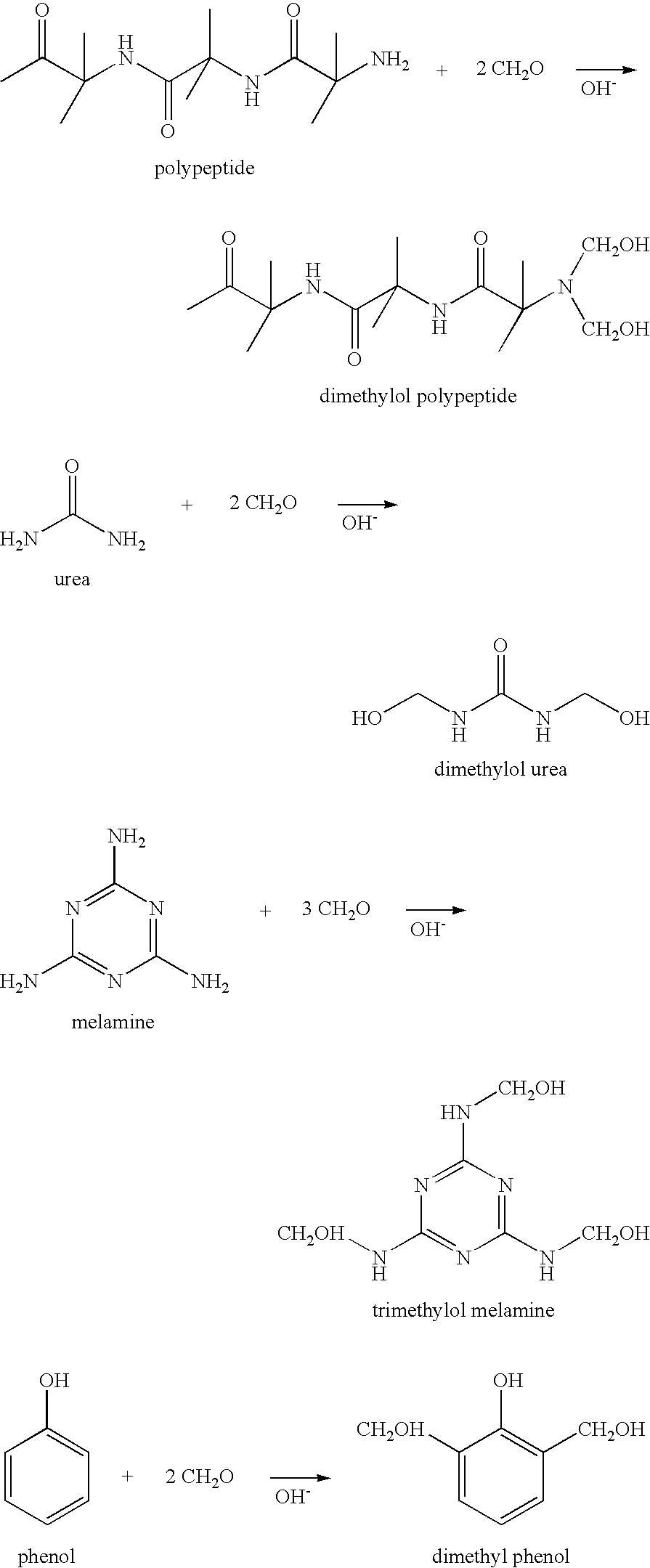Novel hybrid binder with natural compounds for low emission products
a technology of natural compounds and binder, applied in the field of lignocellulosic or cellulosic materials, can solve the problems of significant detrimental changes in physical and/or chemical properties, reduced efficiency under the same running conditions, and reduced production efficiency, etc., to achieve high hardening, low formaldehyde emission, and fast cross-linking
- Summary
- Abstract
- Description
- Claims
- Application Information
AI Technical Summary
Benefits of technology
Problems solved by technology
Method used
Image
Examples
example 1
Binder Resin Composition Containing ncPF, Urea and Formaldehyde)
[0110]First, ncPF is prepared. A water-based derivative of wheat (having a concentration (solid content) of 50%, pH of 4.3 and viscosity of 103 mPas, with approximately 7.6% protein and approximately 47% sugars, based on the solids content) is condensed with a pre-condensed phenol-formaldehyde resin under alkaline conditions to give a viscosity of 150 mPas, pH of 9.5 and a solids content of 59% to give ncPF.
[0111]Second, the binder resin composition is prepared. 428.7 g Formaldehyde at (51%) is added 8.2 g ncPF at 50% solids. After 10 minutes, 121.5 g urea is added. The reaction exothermically increases the temperature to 80° C. 106.9 g of urea is then added. The reaction exothermically increases the temperature to 97° C. After 10-30 minutes, the batch is cooled down to 92° C. The pH is adjusted with organic acid to 5.4. The batch is condensed at 92° C. At the desired viscosity of 304 mPas, 368.0 g of ncPF and 30.7 g fo...
example 2
Application of the Hybrid Binder (as Co-Condensate) in Preparation of a Single Layer of a Composite Board
[0114]The binder of Example 1 is mixed with 0.5%-1% solid hardener to solid resin. The glue mix is sprayed on the fibers at a loading of 10% binder to dry wood.
[0115]When the composite board is an MDF board, the MDF board is produced at 6.2 s / mm.
example 3
Application of the Hybrid Binder (as Co-Condensate) in Preparation of a Multi Layer Composite Board
[0116]In the following table, a urea formaldehyde resin is used as the amino resin for the adhesive binder. The adhesive binder is applied to a particle board at the loadings and press times given in the table.
LoadingSpecificPerforator(solid resin %press timevalueAdhesiveon solid(laboratoryaccording toBoardbinderwood)press)EN 1201FaceAmino107.53.3CoreAmino102FaceBinder of107.5Example 1CoreAmino10
[0117]The entries for Boards 1 and 2, as described in the above-table are theoretical values. These values show that it is expected to have reduced formaldehyde emissions when the hybrid binder of the present invention is used in the face of the board.
PUM
| Property | Measurement | Unit |
|---|---|---|
| Fraction | aaaaa | aaaaa |
| Density | aaaaa | aaaaa |
| Density | aaaaa | aaaaa |
Abstract
Description
Claims
Application Information
 Login to view more
Login to view more - R&D Engineer
- R&D Manager
- IP Professional
- Industry Leading Data Capabilities
- Powerful AI technology
- Patent DNA Extraction
Browse by: Latest US Patents, China's latest patents, Technical Efficacy Thesaurus, Application Domain, Technology Topic.
© 2024 PatSnap. All rights reserved.Legal|Privacy policy|Modern Slavery Act Transparency Statement|Sitemap

